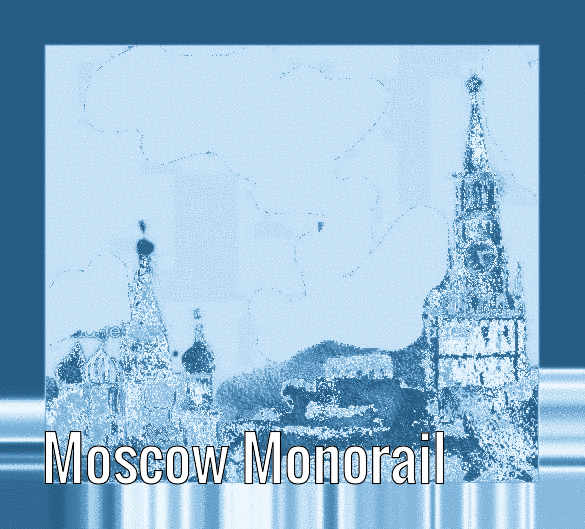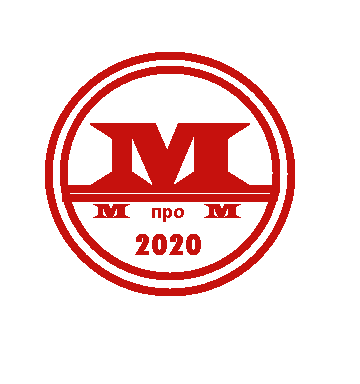
The Moscow Monorail (Russian: Московский монорельс) is a 4.7-kilometre-long (2.9 mi) monorail line located in the North-Eastern Administrative Okrug of Moscow, Russia. It runs from the Timiryazevskaya via Fonvisinskaya and VDNHa metro stations to Sergeya Eisensteina street. The monorail line currently has six stations. Planning of the monorail in Moscow started in 1998. This was a unique project for Russian companies, which did not have prior experience in building monorails. 6,335,510,000 rubles (about US$240 million) were spent by the city of Moscow on the monorail construction.
On 20 November 2004, the monorail opened in «excursion mode.» On 10 January 2008, the monorail’s operation mode was changed to «transportation mode» with more frequent train service. Ticket prices were reduced from 50 rubles ($2.00) to 19 rubles ($0.80), which was the standard fare for Moscow’s rapid transport at that time; as of 2012, ticket prices still matched the standard fare, but multi-ride passes could not be used between systems. In April 2012, one of Moscow’s transport officials announced that he believed that the system should be closed down and dismantled in the future. However, on 3 October 2012, the vice mayor of Moscow said that the Moscow Monorail would not be closed because of lack of public transportation and very busy highways in that particular part of the city.
Since 1 January 2013, all metro tickets have been valid for the monorail. Interchange from the Metro to the Monorail and vice versa is free for 90 minutes after entering the Metro or Monorail.
The Moscow Metro operates the monorail, which in 2016 officially became the Line 13 of the network.
In the 1990s, Moscow’s streets were suffering from traffic congestion by private cars, which significantly interfered with public transport. This situation renewed interest in the monorail which could unload ground public transport. Estimates were published in the media that showed that building monorails would be 5-7 times cheaper than building new underground metro lines.
The decision to start monorail planning in Moscow was made by the Mayor of Moscow Yury Luzhkov after consultations with Yury Solomonov, the head of state-run Moscow Institute of Thermal Technology (MITT) and Luzhkov’s close associate. (Luzhkov and Solomonov jointly patented 19 inventions, including patent RU 2180295 «Monorail transport system». In 1999, Solomonov directed Luzhkov’s mayoral election campaign.) MITT previously developed military technology but had no prior experience in monorail design. At the end of the 1990s, MITT urgently needed funding and looked for contracts from the Government of Moscow.
On 17 July 1998, Luzhkov tasked MITT, the Office of Transport and Communications and Moskomarchitechtura (NIiPI General Plan of Moscow) to draft the Moscow Monorail program and to prepare a preliminary technological and economical justification for the development of monorail routes in Moscow. These tasks were formulated in a short decree 777-RP «On the financing of project works on monorail transportation». MITT received 1.4 million rubles from Moscow budget. Deputy Premier of Moscow Government B.V. Nikolsky was assigned to supervise the project.
On 2 September 1998, Luzhkov signed a decree 996-RP «On the design and construction of new types of high-speed transportation in Moscow» which justified the development of monorail lines in Moscow. The decree stated that traditional public transportation could not handle the increasing passenger loads and that cardinal solution to that problem would be possible only through the development of new types of high-speed transportation that meet modern ecological and economical requirements, are comfortable and could be integrated with traditional transportation. The decree instructed the Office of Transport and Communications and the state-run Moscow Institute of Thermal Engineering to continue work on the Moscow monorail transportation and to draft the layout of monorail lines by the first quarter of 1999. Luzhkov’s decree proposed three monorail lines: from Novogireevo metro to Nikolo-Archangelskoe cemetery, from the metro Vykhino to Zhulebno district and from Krylatskoe to Krasnaya Presnya. However, these proposed lines were later canceled. Again, B.V. Nikolsky supervised the project.
On 16 February 1999, the decree 108-PP established an open joint-stock company Moscow Monorail. The company was co-founded by the Department of State and the municipal property of Moscow City which acted on behalf of the Government of Moscow and had a 25% + 1 share. The total starting capital of Moscow Monorail was 100 million rubles. Vladimir Grigorievich Sister, the prefect of the North-Eastern Administrative Okrug, represented the Government of Moscow in the company. General supervision over the decree implementation was conducted by B.V. Nikolsky. On 3 August 1999, Luzhkov’s decree 738-RP established a commission for the supervision of the monorail works in the North-Eastern Administrative Okrug. Sister became the commission head.
By the first quarter of 2000, an experimental monorail test set was built at the MITT campus. Several trains were purchased from the Swiss company Intamin. The decree 49-PP specified the rules, regulations and parameters for the construction of the Moscow Monorail.
On 20 November 2004, the monorail carried its first passengers. At that time the monorail was running two trains at 30-minute intervals while the only boarding and exiting station was Ulitsa Sergeya Eisensteina. The monorail ran from 10:00 to 16:00, by the suggestion of Moskovsky Metropoliten. On 29 November, Timiryazevskaya station was opened for boarding and exiting. The cost for one ride during the excursion period was 50 rubles for adults, 25 rubles for students (6 years of age or older) of universities, institutes and colleges and free rides for children under six years of age (later changed to seven).
At the beginning of 2005, a project for the continuation of the route was approved and the costs of that project were estimated. In July, the travel time from Timeryzevskaya to Ulitsa Sergei Eisensteina was cut down to about 22 minutes, the line’s operating hours were extended to encompass 8:00 to 20:00 and the stations Vystavotchny Tsentr and Teletsentr were opened for passenger boarding and exiting. On 6 February, electrical equipment near Vystavochny Tsentr station caught fire, with no injuries. Based on previous experience, the monorail was closed until 11 February, due to concern of a possible high voltage leak near the accident area.
On 7 May and 1 June, two accidents involving damage of the third rail happened. Repair work in both cases took several days. It was decided to perform additional monorail reliability checks which suspended its opening until Q2 2006.
The last station was opened on 1 September 2006. On 19 and 20 October, the trial was conducted to assess the readiness of the line to have six trains en route simultaneously. According to the monorail staff, these trials showed the lack of sufficient reliability of the rolling stock. Because of this, the launch of the transportation mode is delayed to Q1 2007.
During the off-hours of 26 December 2006, approximately 400 metres (1,300 ft) of trolley cable was damaged between stations Vystavochny Tsentr and Ulitsa Sergeya Eisensteina. The damaged site was repaired quickly and, on 30 December, the line continued operation. Trolleys may have been damaged by an excavator or other heavy equipment. On 27 December, the repaired EPS 01 train was accepted for service and soon cannibalized for spare parts.
-
Timiryazevskaya
-
Ulitsa Milashenkova
-
Teletsentr
-
Ulitsa Akademika Korolyova
-
Vystavochny Tsentr
-
Ulitsa Sergeya Eyzenshteyna



